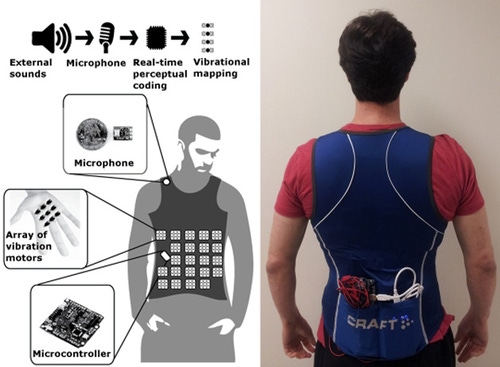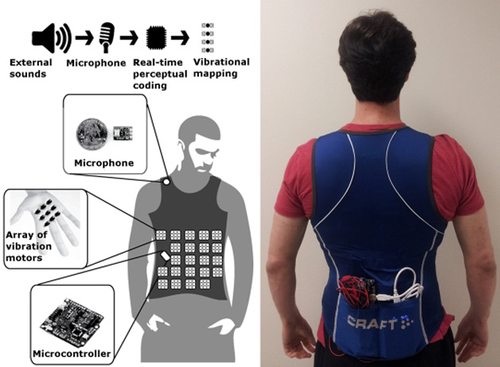This VEST Will Give You Extra Senses
November 3, 2014


Dr. David Eagleman, a neuroscientist at Baylor College of Medicine in Houston and graduate student Scott Novich are “on a mission to see how far we can push the limits of human perception, and what it means to be human in general.” The two researchers have successfully crowdfunded a wearable vest technology that will give the hearing-impaired a new sense of sound. The Vibrotactile Extra-Sensory Transducer (VEST) is literally a vest (weighing 10 lbs in its current incarnation), one that turns audible sound received from a smartphone into tiny vibrations on the skin that the brain then interprets as sound. It's the same principle behind the cochlear implant, but it works noninvasively without the need for surgery. The hope and theory is that, with training, deaf users will be able to entirely regain their hearing by wearing the device.
Their successful Kickstarter campaign means that Eagleman and Novich will be able to create a better prototype and conduct further research — including behavioral testing and brain imaging studies, all of which they plan to submit to scientific journals.
Related articles on DesignNews.com
Traditionally, the cochlear implant has been the go-to treatment for those who are born deaf or are suffering severe or profound hearing loss. Where hearing aids function to amplify sound, cochlear implants stimulate the auditory nerve directly. However, the electronic implants require surgery, have shown mixed results, and can cost at least $40,000. According to the National Institute of Health, approximately 324,000 people worldwide have received cochlear implants as of December 2012. In the US, roughly 58,000 adults and 38,000 children have cochlear implants. VEST is a proposed solution that Eagleman and Novich believe “would cost orders of magnitude less than cochlear implants (hundreds-to-thousands as a opposed to tens-of-thousands), be discrete, and give the wearer the freedom to not be attached to it all the time.”
Sensory-substitution has been around for quite some time. In fact for the simplest example you just have to look at the blind and vision impaired who read using braille. The tactile sensation translates to a visual indication. In 1969 Paul Bach-y-Rita developed the Brainport — a tactile chair/video camera combination that allowed blind participants to develop a visual intuition for sensations they felt. While Eagleman and Novich say they will focus on refining the VEST for deployment to the hearing-impaired, they may also experiment later with consumer-grade VESTs aimed at expanding everyday human perception. In a talk at the 2013 Being Human Conference in San Francisco, Eagleman can barely contain his excitement talking about VEST's potential to expand human perception – including one tested feature to monitor stock market prices.“I don't have to pay any attention to it, but what I'm doing is tapping into the ebbs and flows of the economy of the world.”
He also discussed an idea of plugging VEST into your Twitter feed – meaning you would literally feel when people are talking about you or a topic of interest. “As I walk around in the VEST all day I'm plugged into the consciousness of a thousand people,” Eagleman says. “And that's just an experience that humans haven't had before.”
Dr. Eagleman demonstrates VEST at the 2013 Being Human Conference:
About the Author(s)
You May Also Like





